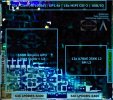That's good info but is still looks high for portable mode. For demanding online games 6 TPC 420MHz is 5.7W for the GPU, 1.4-2W CPU, then the rest of the system like screen at medium brightness, wifi, storage etc is probably 2-3W so that's about 9-10W total. GPU power consumption from 420 to 522MHz is +0.8W, going down to 250-300MHz probably scales similarly, say -1-1.5W which puts it on the edge. I'm more optimistic but not 100% convinced about 6 TPC for portable, 3TPC 420MHz is 3.3W, 2.4W less so about 6.5-7.5W total which sounds much more realistic
6 TPC 624MHz is 8.6W, again 1.4-2W CPU, docked doesn't use the screen which saves power so 1-1.5W (excluding USB ports and other docked features), 11-12W docked sounds plausible. Wishlist would be 6 TPC 250MHz portable, 600MHz docked, 1GHz CPU but definitely not expecting it
Yeah this is my chart, it's important to remember that these numbers are at high load, when comparing to Zelda botw at launch (Erista 20nm), that is why I made a medium load to the right for each number. This better reflects the comparison with Zelda botw's power draw in portable mode and docked mode as those numbers were widely reported.
On Erista launch Switch models, with everything at minimum/off, portable mode during gameplay was 7.1w and with everything on/max brightness, it was 9w. Nintendo said that gameplay during Zelda was about 3 hours, and with a 7.1w power consumption on a 21.5wh battery, yeah 3 hours is about right. We know from the above power draw that during Zelda gameplay, the SoC drew a little over 5w.
We also know now that LPDDR5 uses 1.5w for 128bit @ 102GB/s, which is the likely RAM configuration for Drake, also from the hack earlier this year, we know that all SMs are active at all times, there is no configuration in the NVN2 API for fewer than 12SM.
I think we should take into account increased battery density, which increases about 5% per year, now I'm not saying that we will see a ~6000mah battery, but given entry level smart phones use 5000Mah, and Switch had a 4315Mah battery which at 5v was 21.5wh, 5000Mah @5v is 25wh, so the SoC could draw around 7watts considering that the original Switch's screen was a huge power waster, and with OLED, you'd consume a lot less, giving you up to 9w for the whole system at minimum spec would be very similar battery life for a Drake exclusive. It's worth noting that power draw should be much lower for Switch games, and with TotK being a likely launch target, they could probably advertise over 5 hours in that game.
Anyways, with everything taken into account, I think something around the 420MHz GPU (5.1w) ~1.3TFLOPs, and ~1.5GHz CPU (2.1w) would be fine (especially because the OS core could be minimum clocked, offering a ~1.85w). It's worth noting that botw is not the most demanding game on Switch, and launch units can see ~2hours of game play on the most demanding titles, suggesting that the original SoC can draw around 7w total.
All the estimates are on Samsung 8nm, which is currently the worst case scenario, it's possible that they are actually using a more advance node, that being Samsung 5nm, TSMC 6nm or TSMC's 4N (Nvidia's custom 5nm process node). All of which would allow for much higher clocks.
As for docked clocks, I think the CPU will remain at the same clock just like with the current Switch, but the GPU will probably ~double it's clock speed, suggesting a ~2.5TFLOPs docked performance on 8nm.

 arstechnica.com
arstechnica.com




